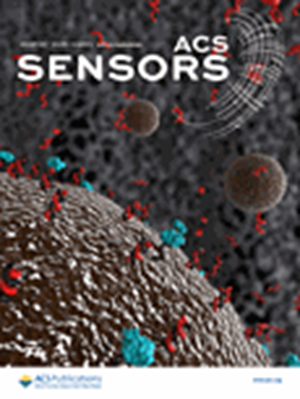柔性Mo2CTx/MoSe2异质结构传感器用于牙周炎诊断中呼出H2S的超灵敏、室温检测。
IF 8.2
1区 化学
Q1 CHEMISTRY, ANALYTICAL
引用次数: 0
摘要
口腔硫化氢(H2S)水平是非侵袭性牙周炎的重要生物标志物,其敏感性和选择性检测对早期诊断和实时监测至关重要。然而,在复杂的口腔环境中,当前的传感技术在实现高灵敏度、选择性和稳定性方面仍然面临着很大的局限性。在这项研究中,我们报道了一种二维Mo2CTx修饰的MoSe2 (Mo2CTx/MoSe2复合材料)的集成异质结构的发展,专门用于牙周炎诊断中的室温H2S检测。该复合材料将Mo2CTx的高导电性和丰富的表面缺陷与MoSe2的带隙可调节性和化学特异性协同结合,产生了出色的气敏性能。优化后的Mo2CTx/MoSe2传感器(0.5 wt % Mo2CTx)具有高响应(ΔR/R0 = 629%, H2S浓度为10 ppm)、超低检测限(22 ppb)和卓越的选择性(对干扰气体的选择性为3.9-628倍)。此外,它还表现出优异的长期稳定性(40天内信号漂移<11%)和机械稳健性,强调了其临床部署的适用性。密度泛函理论模拟表明,传感性能的增强来自于异质界面强电子耦合、加速电荷转移和高效的H2S分子活化。实时呼吸分析证实了传感器动态跟踪H2S水平的能力,能够有效区分健康个体和牙周炎患者。这项工作为牙周炎的早期诊断筛查提供了一个强大的和可扩展的策略,并为下一代可穿戴或智能口腔保健诊断平台奠定了基础。本文章由计算机程序翻译,如有差异,请以英文原文为准。
Flexible Mo2CTx/MoSe2 Heterostructure Sensors for Ultrasensitive, Room-Temperature Detection of Exhaled H2S in Periodontitis Diagnosis.
Oral hydrogen sulfide (H2S) level is a critical biomarker for noninvasive periodontitis, making its sensitive and selective detection essential for early diagnosis and real-time monitoring. However, current sensing technologies still face significant limitations in achieving high sensitivity, selectivity, and stability within the complex oral environment. In this study, we report the development of an integrated heterostructure of two-dimensional Mo2CTx-modified MoSe2 (Mo2CTx/MoSe2 composite), tailored for room temperature H2S detection in periodontitis diagnosis. The composite synergistically combines the high electrical conductivity and abundant surface defects of Mo2CTx with the bandgap tunability and chemical specificity of MoSe2, yielding an outstanding gas-sensing performance. The optimized Mo2CTx/MoSe2 sensor (0.5 wt % Mo2CTx) demonstrated a high response (ΔR/R0 = 629% to 10 ppm of H2S), an ultralow detection limit (22 ppb), and superior selectivity (3.9-628 times against interfering gases). Moreover, it exhibited excellent long-term stability (<11% signal drift over 40 days) and mechanical robustness, underscoring its suitability for clinical deployment. Density functional theory simulations revealed that enhanced sensing performance arises from strong electronic coupling at the heterointerface, accelerated charge transfer, and efficient molecular activation of H2S. Real-time breath analysis confirmed the sensor's ability to dynamically track trace H2S levels, enabling effective discrimination between healthy individuals and periodontitis patients. This work presents a robust and scalable strategy for the early diagnostic screening of periodontitis and lays the groundwork for next-generation wearable or smart diagnostic platforms in oral healthcare.
求助全文
通过发布文献求助,成功后即可免费获取论文全文。
去求助
来源期刊

ACS Sensors
Chemical Engineering-Bioengineering
CiteScore
14.50
自引率
3.40%
发文量
372
期刊介绍:
ACS Sensors is a peer-reviewed research journal that focuses on the dissemination of new and original knowledge in the field of sensor science, particularly those that selectively sense chemical or biological species or processes. The journal covers a broad range of topics, including but not limited to biosensors, chemical sensors, gas sensors, intracellular sensors, single molecule sensors, cell chips, and microfluidic devices. It aims to publish articles that address conceptual advances in sensing technology applicable to various types of analytes or application papers that report on the use of existing sensing concepts in new ways or for new analytes.
 求助内容:
求助内容: 应助结果提醒方式:
应助结果提醒方式:


